Our modern perception of time, with its almost slavish devotion to millisecond accuracy, was a totally alien concept to even our recent ancestors. Although mechanical timepieces were known even in the ancient world, time and timekeeping were inexact. Accuracy was generally low, with devices often “drifting” significantly. Where public clocks were in use, men employed as clock setters periodically adjusted a city’s clocks according to local custom, which was generally based on local mean time. This was based on the position of the sun at noon, since each degree of longitudinal movement around the globe represents a difference of roughly 4 minutes on a solar-based time system. Under solar time, if it was noon in Boston it was 11:24 in Charleston, South Carolina, 11:36 in Washington. DC, 11:48 in New York City, and so forth.
This system worked because communities were relatively isolated from one another, and the idea of time based on the sun’s position was well understood. There was no need for pinpoint accuracy. A person traveling by foot, or even by horse, was not concerned with exact time schedules and certainly had no need or desire to know precisely when they might arrive at their destination. Upon arrival, they simply adjusted their watch (if they owned one) to the local mean time customary to that location.
Most histories cite the rise of the railroads, with their complex timetables and need for precision across larger distances, as the impetus behind the creation of what we now know as Standard Time. This is overly simplistic, however. While railroads were indeed a factor in the equation, other groups (including astronomers and telegraph companies) played a much larger initial role in its adoption. Railroad companies jumped on the bandwagon only later, once it was apparent that standards-based system was about to be adopted. They did so solely to protect their interests, and to guarantee that the new system met their own needs.
Typical early railroad timetable, with no time standard or zone indicated
The Origins of Standard Time
The concept of standard time did not originate in the United States. The United Kingdom adopted the use of a single time zone for the entire country on December 11, 1847, when railways in that country switched from use of local mean time to a single zone based on GMT (Greenwich Mean Time). The UK had the advantage of covering only 8 degrees of longitude, so only one time zone was required. Those communities at the furthest reaches only needed to change their clocks by one-half hour (forward or backward, depending on their location) to adopt GMT as their standard time. Adoption was relatively rapid. By 1855, most of the country’s public clocks were set to GMT.
The United States had a far larger problem, since its territory (excluding Alaska and Hawaii, which were not even states at this time) stretched across 57 degrees of longitude. Hundreds of time standards were in use across the country. One source cites the presence of no fewer than 38 local times in mid 19th century Wisconsin, 27 in Michigan, and 23 in Indiana. Unlike England, the US also lacked a well-known central city or feature on which to base any national system of timekeeping.
An Increased Need for Precision
We have already noted the popular misconception that railroads were the prime motivating force behind the adoption of a standard time system in the US. However, railroads did suffer from time-related problems as their areas of operation grew. To compensate for the plethora of local mean times, each railroad eventually introduced its own corporate timekeeping standard, generally known as railroad time. These times were used to coordinate the movement of trains as well as arrival/departure schedules. In many cases companies adopted the local mean time used at their home office as the official time for their entire line. A Philadelphia company adopted that city’s time as its standard, while a New York firm used its own local time to run its own trains.
Boston & Providence RR Standard Time notice (courtesy Harvard University Collection of Historical and Scientific Instruments)
Initially, train timetables were established based on known travel time and distance between stations, a practice that often resulted in accidents and delays. Beginning in the 1850s, schedules were managed using another new piece of technology: the telegraph. Once widely adopted, it allowed railway companies to send updated schedules and other data along the line in a nearly instantaneous manner, warning stations of delayed or disabled trains. By 1855, most companies used telegraphic means to manage schedules and to ensure that trains were spaced safely along the line.
Central RR of New Jersey timetable prior to establishment of Standard Time. Note the comment that “New York Time is the standard, as indicated by the Clock in Elizabeth Station”
This system worked well, but often generated confusion among passengers. A traveler arriving at a train station served by several lines might be confronted with half a dozen clocks, each set to an individual line’s railroad time. These displayed times might not even match the local mean time for the station, thus adding another dimension of complexity. Anyone scheduling a trip involving multiple railway companies had to account for differences in each company’s standard, since in some cases the arrival time of a train operated by one line might be later than the departure time used by another. So while railroad companies were fully capable of operating under their own time system, this scheme did nothing for the passenger.
The first known discussion of a standardized railroad time in the United States came in 1852, when a writer in an industry journal recommended that New York City’s time be adopted by all operating companies as “the first [or sole] meridian of railroad time.” No serious discussion of this suggestion appears to have resulted, though the subject was brought up occasionally afterward.
It was not until 1869, when Charles F Dowd presented a plan at a New York convention of trunk line (railway) operators, that some momentum toward adoption of a national railroad time began. Dowd noted the confusion travelers felt when confronted by multiple independent time systems in use by the various lines, stating that “these variations are governed by no general principle which would enable a person familiar with them in one locality, to judge of them in another. Any traveler, therefore, upon leaving home, loses all confidence in his watch, and is, in fact, without any reliable time.” He proposed a system that adopted Washington DC’s local mean time to manage all national railroad schedules, with each city retaining its own local mean time for other purposes. A year later he elaborated this system still further by proposing four zones, indexed on the Washington meridian. Each would be separated by one hour, which would become the standard railroad time for that zone.
Charles Dowd’s Proposed system of time zones
However, after some initial discussion the railroads lost interest in such a plan, remarking that “the disadvantages the system seeks to avoid are not of such serious consequences as to call for any immediate action on the part of railroad companies.” In other words, companies were perfectly content with their existing system of “private” railroad times and apparently felt any inconvenience and confusion it caused individual travelers was not their problem to solve.
Astronomical Influences
With railroads losing interest, the task of gathering support for a standard time scheme fell to another group. Astronomers also had the problem of maintaining a universal time system for the purposes of coordinating celestial observations. In 1875 a researcher named Cleveland Abbe wrote of the difficulties he experienced when attempting to coordinate observations of an aurora borealis on April 7, 1874. He had recruited 100 observers – twenty from the Army’s Signal Service along with eighty volunteers – in an attempt to determine the aurora’s altitude above the Earth, which was then an unknown quantity. These observers were instructed to telegraph observations of the aurora, along with the precise time the phenomenon became visible, to Abbe’s office. They were instructed to note their exact location and to state the time in terms of local mean time. Abbe could then identify and correct each time to a single standard.
The experiment failed because, as Abbe stated, “the errors of the Observers’ clocks and watches, and even of the standards of time used by them, are generally not stated…so that the uncertainty of this vitally important matter will be found to throw obscurity upon some interesting features.” He also discovered later on that some had used railroad time rather than local mean time. This lack of accuracy rendered many of the observations useless for his purposes.
Cleveland Abbe (1838-1916), first
chief meteorologist of the US weather service
Abbe’s letter, which was written to the relatively new American Meteorological Society, urged “action by the Society to secure the adoption of a uniform standard of time.” The Society formed a Committee on Standard Time, with Abbe as chairman, and began researching options. In 1879 the committee issued its Report on Standard Time, which became a key document in the adoption of uniform time across the United States. This report noted the seventy-five “standard” times then in use by the railroads, and recommended adoption of no more than five time zones for North America. These would be known as “Railroad and Telegraph Time” and would be indexed to the Greenwich Meridian – GMT.
However, the document went further. It recommended a subsequent step involving the establishment of a national standard for the United States using a single meridian through the Mississippi Valley that would be six hours earlier than Greenwich Time. Cities and towns would discontinue the use of local mean time, instead adopting the time standard in use by their primary local railroad. The whole system was to be implemented by the railroad and telegraph companies, since they were already equipped to manage such a large venture and had experience managing time schedules across long distances.
In 1880 Abbe also began corresponding with Sanford Fleming, a Canadian railway engineer who was starting his own campaign for adoption of a prime meridian system using a single, universal world time. In one of his letters to Fleming, Abbe wrote that his goal was to have the rail and telegraph companies “make a beginning,” and then to “hammer away at our national congress to call for its action on the subject.” The pair also called for an international convention to discuss the problem of standard time, which also plagued many steamship and other companies involved in wide-ranging trade. This partnership, as well as growing international interest in resolving the problem, eventually resulted in the International Meridian Conference, held in Washington DC in 1884. However, a great deal of progress was made between 1881 and 1884 that eventually resulted in the creation of Standard Time zones for the US and Canada.
Sanford Fleming, Canadian Railroad
Engineer and Standard Time advocate
First, legislative efforts began to bear fruit. In 1881, an astronomer at Yale University persuaded the Connecticut legislature to enact a statute making New York City’s local time the standard for Connecticut. This was the first legislation of its type, and forced local railroads to display this time in their stations. In that same year, the Naval Observatory caused a bill to be introduced into the US House of Representatives. This bill “specified the Naval Observatory’s Washington time for official uses” – in other words, it established a national time standard, similar to railroad time, for official national business. This bill died in committee and was not enacted, but it showed that interest in establishment of a national standard existed even at the Federal level.
In 1882 petitions to the President from the American Metrological Society and other concerned groups persuaded the President to sign an act authorizing Abbe “to call an International Conference to fix on and recommend for universal adoption a common prime meridian, to be used…in the regulation of time throughout the world.” Soon afterward, the State Department sent invitations to various foreign governments, asking them to participate.
In the same year, observatory directors (who were the nation’s de facto timekeepers) and groups such as the American Society of Civil Engineers began discussing a multi-zone time system for use across the United States. Such a system, they realized, could meet the needs of the scientific community as well as railroads, steamship companies, and the public at large.
The Railroads Take Charge
As part of efforts to stimulate adoption, Abbe’s committee invited various industrialists and scientists to participate in the Society. One went to William F Allen, secretary of a General Time Convention maintained by US railroad companies. In April 1883 Allen, having become aware of efforts being made toward adoption of Standard Time by other agencies, wrote an editorial for the General Time Convention. He stated that “We should settle this question among ourselves, and not entrust it to the infinite wisdom of the…State legislatures.” Laws were seen as unwelcome because “there is little likelihood of any law being adopted in Washington, effecting [sic] railways, that would be as universally to the railway companies.”
The adoption of Standard Time accelerated following Allen’s editorial. It is clear railroads had no internal need to adopt the new system. Instead, their interest in implementing a national standard stemmed from a desire to prevent “outsiders” from designing a system that might not be in the railroads’ best interests.
Meetings in 1883 formalized the system of meridians, then known as Standard Railway Time, each exactly one hour apart, that formed the basis for Standard Time. By a happy coincidence, the proposed Eastern meridian of Allen’s system coincided within 6 seconds of GMT, which was 5 hours away. This reinforced Allen’s belief that Greenwich time should be adopted as a world standard.
Despite scattered opposition from individuals claiming a departure from solar time was against God’s will or “unnatural,” Standard Railway Time was formally implemented on November 18, 1883. Allen wrote that on that date in Philadelphia, “the time-ball made its rapid descent, the chimes of old Trinity rang twelve measured strokes, and local time was abandoned, probably forever.” The new system was almost universally adopted within a year. New Yorkers set their clocks back four minutes. Chicagoans stopped theirs for nine minutes. Those in Philadelphia, New Orleans, and Denver did nothing since they were located at the base meridian for their time zone.
Official Railroad Guide December 1883,
following adoption of Standard Railway Time
Naturally, some conflict occurred. A few towns refused to adopt the new system. A Boston man was threatened with arrest because he arrived several minutes late for an appointment with a local judge who refused to acknowledge the new time system. In 1918, the US formally adopted Standard Time and abolished all local timekeeping. The modern era had arrived, for better or for worse.
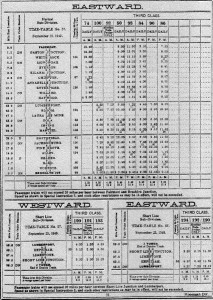
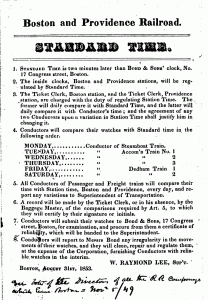
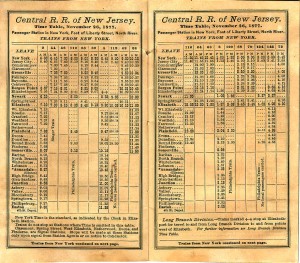
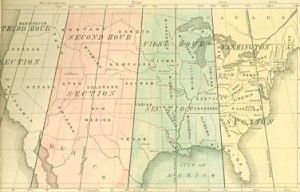
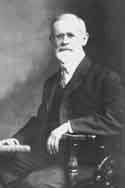
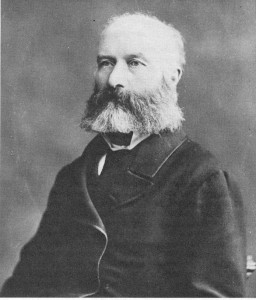
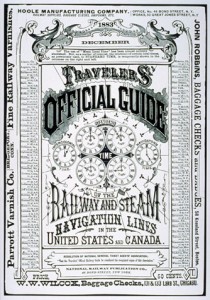
Leave a Reply